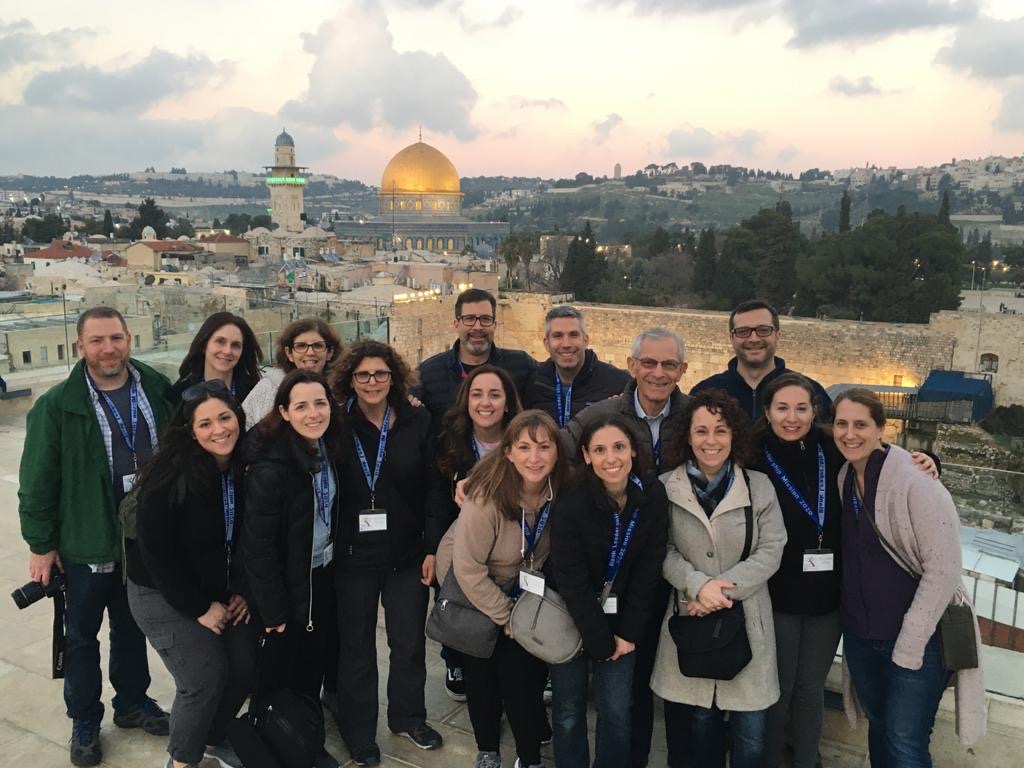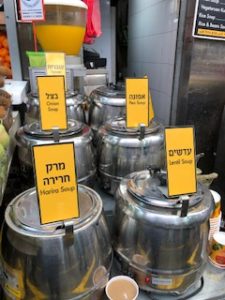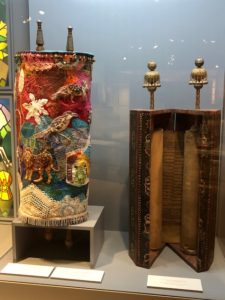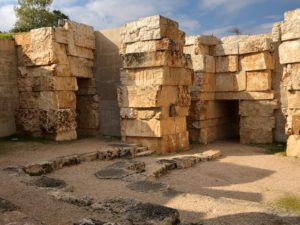Posted on April 7, 2020 by Caryn Shinske
Fate has just handed you the trip of a lifetime to a place you’ve always wanted to see, but didn’t think would ever happen, and in a way that most visitors would never experience.
You tell family and friends, hoping they’ll share your happiness. In most cases, they do. But then the inevitable questions come when some learn the trip is to Israel.
“Are you scared?”
“Will you be safe?”
“Is it a good time to go there, with all the fighting and tension?”
“I don’t know that I could go there and risk my safety.
Aren’t you worried?”
Once I was accepted into the Blank Leadership Development Program through the Jewish Federation of Somerset, Hunterdon and Warren Counties (JFEDSHAW), I didn’t give those four questions much thought.
The program is spearheaded by George and Harriet Blank to help develop the next generation of leaders in our Jewish communities. The Blanks are very active in a variety of philanthropic endeavors to support Israel and JFEDSHAW.
I didn’t know a thing about the program until I was contacted in spring 2019 by Temple Beth-El leadership, asking if I would accept being nominated for the program. My many work and personal responsibilities made me a bit skeptical at first, but I decided to talk to other TBE congregants who were past program participants. Each of them assured me the program was a worthy experience, if not downright life-changing.
After mulling it over, I agreed to be nominated for the program. Weeks later, I went before a JFEDSHAW selection committee for an interview. I eventually received a letter in June confirming my acceptance and detailing a list of requirements for participation.
Starting in September, I and 14 other Blank fellows, as we would come to be known, began attending monthly classes focused on various aspects of leadership and their connection to Judaism. We had presentations by and discussions with business leaders, scholars and clergy. Conversations started in December about the mission trip that we would be taking to Israel from Feb. 19 to 28. We had our final class in March and will “graduate” in June.

The Blank Leadership fellows with George Blank (back row, second from right) atop the Aish HaTorah World Center building and the Kotel in the distance.
This Israel trip wasn’t going to be several days at the Dead Sea, Eilat or shopping at the shuk. This was a serious trip, where we would meet with renowned educators, teach us everything we didn’t know about Israel, how Israel views the Diaspora, and how it all ties into Jewish leadership — advocating for Israel, understanding and appreciating our history, and leading our communities back home. Every day was going to be a 12-to-14 hour schedule of activities including lectures, presentations by the fellows on why specific parashot are moral lessons in leadership, history lessons in front of centuries-old structures and some fun, too.
It turned out that every day was special and more amazing than the previous one. The day we arrived in Israel, we recited Shehechiyanu from the rooftop of the Aish HaTorah building facing the Kotel, wrote out prayers to place in the Western Wall, and then sang and danced with strangers and armed soldiers during Kabbalat Shabbat.
We shared Shabbat dinner with Israel Defense Forces soldiers, who told us why they left their native lands and families to come and defend Israel. On another night, we broke bread at the Brothers For Life club home with IDF combat veterans, who told us about their injuries and efforts to break the stigma of mental illness resulting from post-traumatic stress disorder.
I listened with awe as a tough-looking IDF brigadier general talked about the importance of practicing chesed, or kindness, before taking us further into a southern Israel military base near the Gaza border to witness training exercises.
We went to Yad Vashem to pay respects to those who suffered through the Holocaust, and to remind ourselves why it is up to us and future generations to ensure such a heinous reign and master plan never happen again.
We visited sick children at a hospital and home in Holon, to appreciate why Israel will take children from around the world – enemy countries included – to give them life-changing heart surgeries.
Just about everything I have ever learned and intuited about being a Jew was challenged. I came to recognize that my Jewish identity of going to temple twice a month on average, being able to read Hebrew – but neither translate nor understand it – and participating in culturally related activities isn’t enough anymore. My Judaism has been a block of Swiss cheese…a foundation, but full of holes. I want to fill in those holes and continue learning.
This trip humbled me on multiple levels. It made me realize that the struggles my parents went through to put my siblings and me through Hebrew school and bar and bat mitzvahs were an incredible gift that I cannot squander.
It made me appreciate the depth of love of Judaism that my Orthodox family members wear on their sleeves and social media accounts.

Author Caryn Shinske on the border of Syria, with Mount Hermon in the background.
It helped me understand that being a Jew is about identity. It’s about being myself, living my birthright, loving my cultural traditions and ensuring that my being a proud Jew isn’t limited to a couple of Kabbalat Shabbat services every now and then. It means singing, dancing, reading, creating and sharing memories, understanding the Hebrew I’m reading, defending the validity of the Jewish state, remembering one more name from the Holocaust and so much more.
So now that I’m home, I’ve finally had time to ponder those original four questions, and a fifth.
Was I scared? Never.
Was I safe? I had the luxury of being on a highly structured and organized tour with a top-notch tour guide and private bus driver. But I also saw many people of all ages all over the country living their lives outdoors, whether walking to a destination, waiting for public transportation, shopping for Shabbat or just enjoying a stroll through the Arab market or the different quarters of the Old City.
Was it a good time to go? Absolutely. The almond trees were in bloom, and I recalled with fondness our Tu Bishvat seder at TBE just weeks prior to the mission trip, when Rabbi Arnie talked about the dormant and growing seasons in Israel.
Was I worried? Yes, but only because the mission went too fast and I wanted more time there. That’s why Israel is part of my 2021 summer vacation agenda.And was the trip life-changing? More than you’ll ever know.
I humbly and graciously thank those at TBE who thought me worthy of this experience, as well as George and Harriet Blank, and JFEDSHAW. Most of all, though, I thank Ray and Gail Shinske, my no-nonsense parents of blessed memory, who made it abundantly clear that getting a Jewish education was a non-negotiable proposition in their home. I’m sure they’re kvelling that I admit they did the right thing.
Feb. 19
Overnight flight from Newark to Tel Aviv.
Feb. 20
We hit the ground running as soon as we landed this afternoon, going from Tel Aviv to Jerusalem, visiting the Old City and Kotel, writing notes to put in the Western Wall, and ending the evening with an introduction by a Hebrew University poly sci professor/former journalist to the Israeli political structure in comparison with the United States. I tried as hard as I could to stay awake but was mortified after realizing I briefly nodded off during the discussion. Maybe I’ll buy one of the professor’s books to ease the Jewish guilt?
Feb. 21
 Family that has visited Israel before warned me about the breakfast. But this wasn’t breakfast. This was a Long Island bar or bat mitzvah cocktail hour on steroids. After saying a hearty hello to my old friends Brie and Gouda, I went for things I normally don’t take the time to savor most mornings: a variety of fresh fruit, some lox … enough protein to fuel the morning without going bonkers.
Family that has visited Israel before warned me about the breakfast. But this wasn’t breakfast. This was a Long Island bar or bat mitzvah cocktail hour on steroids. After saying a hearty hello to my old friends Brie and Gouda, I went for things I normally don’t take the time to savor most mornings: a variety of fresh fruit, some lox … enough protein to fuel the morning without going bonkers.
We had a beautiful day in Jerusalem. After the Grand Canyon-sized breakfast, we listened to a lecture by Avraham Infeld, the most incredible and dynamic speaker I have ever heard, about what it means to be Jewish. Hint: It’s not a religion! Next, we went to the Theodor Herzl museum to learn about his dream for a Jewish State and the efforts put forth to achieve it, followed by a trip to Mount Herzl to visit the graves of great Jewish leaders and heroes.
We spent the early afternoon at the Mahane Yehuda Market, or shuk, then headed to the Kotel for Shabbat, where we sang and danced with strangers who wouldn’t let us stand idly by. Had a wonderful dinner celebrating Shabbat with Israel Defense Forces soldiers and yeshiva students. The lesson of the day? When you’re a Jew in Israel, everyone is family.
Feb. 22
Our final day in Jerusalem was spent going to Sabbath services, where women dominated the clergy, ran the Orthodox service in shipshape fashion and showed us what the future could – and should – look like. And the number of men in attendance was wonderful to see. A former deputy mayor of Jerusalem and Knesset member spoke to us during lunch about her experiences and how Israeli Jews view the Diaspora. We also continued debating the concept of feminism in modern Orthodox Judaism. We spent the afternoon on a walking tour of the Old City, seeing places I have only ever heard about in a classroom or read about in the North Babylon (NY) Public Library Encyclopedia Brittanica for some report I had to write. Incredible seeing 4,000-year-old history in person. The evening was a free night for us to be social and have a good time. And we definitely did. Tomorrow we head north.
Feb. 23
It’s been an emotional day, but one of tremendous learning. We started with a lecture by renowned Holocaust educator Rachel Korazim, who challenged us to view the Holocaust differently from how many of us have been taught, and in a way that has extra meaning and depth. We then went to Yad Vashem, Israel’s Holocaust memorial and museum, for a very moving tour (lots of tears). Afterwards, one of our program founders and leaders told his story of escaping Poland with his mother during the Holocaust, after losing eight relatives, including his father. Following lunch, we headed north toward the Golan Heights and stopped at Givat Haviva to hear about the work it is doing to improve Israeli-Arab relations. And, we heard from three amazing teenagers in Givat Haviva’s International Baccalaureate Program, who gave us their very wise and mature takes on conflict resolution.
Today’s lessons:
Feb. 24

Two Torahs on display Two torahs on display at the Museum of The Jewish People at Beit Hatfutsot in Tel Aviv.
Today we met with Miri Eisin, a retired colonel with the Israel Defense Forces and geopolitical expert, at a viewpoint atop Mount Bental, where Israel meets both Syria and Lebanon. With Mount Hermon in the distance as her backdrop, Col. Eisin gave us an overview of the political tensions in the region, the growth of Hizbollah, and where things stand. Afterwards we took jeep tours through the property of the 250-acre kibbutz resort where we are staying and drove along the border with Syria to get a better understanding of defense needs. We wound down the day with a visit to the Galil Mountain Winery and a wine tasting and used the ride back to the kibbutz to discuss the importance of leaders listening. Today’s lesson: There’s more to Israel than political tension – there are gorgeous surroundings, productive kibbutzes, farming, tasty wine and much more.
Feb. 25
Incredible day today. We left the Golan Heights in the morning and headed south to the Yemin Orde Youth Village to learn how the center is trying – and succeeding – to help at-risk teens from all over the world transform their lives for the better. Dr. Chaim Peri told us how he developed “The Village Way” instruction technique and shared metrics on the positive changes it’s having in Israel.We continued on to Tel Aviv to learn why Israel is “Start up Nation,” visiting the Taglit Birthright Israel Innovation Center and hearing from a tech journalist about why Israelis number three on the NASDAQ behind the United State sand China for number of high-tech startups. We rounded out the day by sharing dinner with combat veterans from the Israel Defense Forces at their Brothers For Life house, listening to their personal stories about fighting terrorists, struggling to recover from physical wounds and ongoing issues with PTSD as they work toward happy, healthy lives. A lot of food for very thorough thought.
Feb. 26

Valley of the Communities on the Yad Vashem campus.
Great day for a walk today around Jaffa and Tel Aviv, followed by a visit to an Israel Defense Forces military base near the Gaza border. We met with Brig. Gen. Bentzi Gruber, who lectured on the IDF’s code of ethics in the field and walked us through what soldiers look for in urban warfare. We spent a good couple of hours at the base but everything else about our visit is … classified. After leaving Gen. Gruber, we visited the town of Sderot, often hit by shellings and missiles. A nice little town where safety shelters are as common on the street as … bus shelters. But life goes on.
Feb. 27

Fellows Caryn Shinske, Ryan Maizel, and Jacki Skole.
A transformative day. We kicked off the morning with a fun but serious lecture about what it means to be a Jew in Israel and then went to Wolfson Hospital in Holon to learn about the Save A Child’s Heart Program. Save A Child’s Heart brings children from around the world to Israel for life-saving heart surgery and related treatments that these children couldn’t get in their home countries. No child is rejected from the program because of where he or she comes from. This is a humanitarian effort that not only saves lives but transforms them! After the hospital we went to a home the program operates to house children and typically their mothers for months at a time. We played with some of the children and enjoyed seeing them smile and have fun. And surprise, surprise … a cell phone tantalizes children from Zanzibar the same way it does children in New Jersey. One of our final stops was Beit Hatfutsot Museum, which had many interesting and fascinating displays, from Judaism in ancient times to Judaism in modern pop culture. Next stop: the hotel, our farewell dinner and then the airport.
Feb. 28:
Homeward bound … I will definitely be back, Israel. Thank you for your hospitality, graciousness and lessons in chesed. I’ve never been prouder to be a Jew.
Originally published in the April 2020 issue of the Shofar. For more issues of the Shofar, visit the Shofar archives.